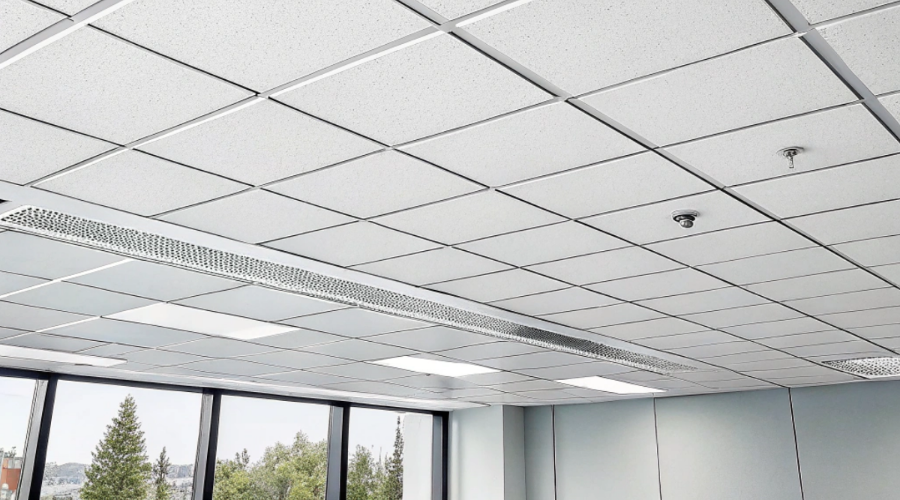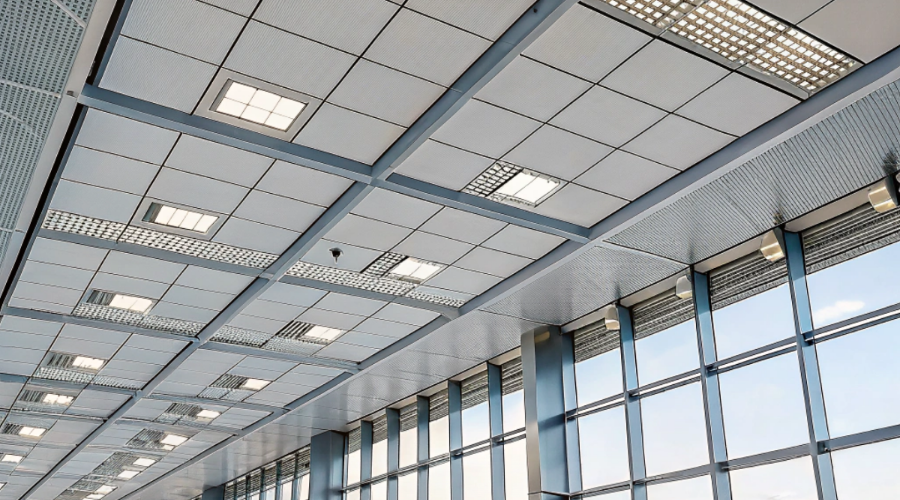Ever walked into a room and thought, “Wow! This ceiling looks so clean, modern and organised. I’d love to have it at home.” That’s the magic of suspended ceiling tiles. They are an excellent option for aesthetic enhancement and energy efficiency.
The majority of homeowners, businesses, and builders love these kinds of ceilings because they hide ugly wires, pipes, and other types of unpleasant things while introducing many styles. Do you want to know how suspended ceilings could change your space? Let’s crack into what makes them such a touchstone for people’s interests.
What is a Suspended Ceiling?
Suspended ceilings are a type of ceiling that hangs below the main ceiling and is supported by a grid system made up of metals or other materials, with tiles or Ceiling panels inserted into it. This ceiling gives a clean appearance by forming an invisible gap between the original ceiling and the suspended ceiling structures.
The space can be used as a hiding place for wiring, pipes, air ducts, etc. Since suspended ceilings are flexible and functional, they have applications in homes, offices, and commercial buildings.
What Types Are Available?
There are many suspended ceiling tiles for several different uses. The main types include:
1. Mineral Fiber Tiles:

Mineral Fiber Ceiling Tiles are among the most highly preferred lightweight tiles with reasonably good acoustic properties and sturdy ceiling tiles. Generally, they are found in office buildings, schools and hospitals.
2. Metal Tiles:

These tiles are the best for sleek finishes for modern interiors. They also make things downright classy. Metal tiles are also durable and are best for restaurants and commercial locations.
3. PVC Tiles:
PVC tiles are waterproof, making them the best choice for kitchens, bathrooms or hard-to-reach areas like the basement. They are also easy to maintain or clean.
4. Wood Tiles:
Wood tiles are the best for the home-type natural feel. Wood tiles are used mainly indoors, especially in the living room or bedroom.
Each type of tile has its advantages. You can now choose on the basis of your own preference in aesthetics and requirement of the space.
Advantages of Suspended Ceilings
With many benefits, suspended ceilings are becoming popular in residential, commercial, and industrial places. Some of those benefits include:
1. Concealing Wires and Utilities:
There are many reasons a suspended ceiling is preferred. One of the most important is to conceal ugly pipes, wires, and ducts. This gives the room an uncluttered, organized appearance without infringing upon the workings of the space.
2. Improved Acoustics:
Suspended ceiling tiles absorb sound, while acoustic tiles may soak up sound well and decrease noise inside a room. Much benefit comes from this aspect in offices, schools, or busy spaces where lots of noise can be a disturbance.
3. Easy Installation and Maintenance:
Compared to traditional ceilings, suspended ceilings may be fixed with a minimal construction effort. Also, the repair or replacement of individual tiles will not cause much disruption to the ongoing activities in your space.
4. Energy Efficiency:
The suspended ceiling is formed in such a way that they insulate and thereby improves the energy efficiency of the particular building. They act as insulation against heat or cold, helping to cut down costs while transforming your space into an energy-saving and budget-friendly place in the long run.
5. Aesthetic Appeal:
Suspended ceilings come in all forms and designs to beautify any space. Whether you want your space to feel modern, simple, or traditional, a suspended ceiling would complement your styling needs.
Installation Process of Suspended Ceilings
It is a little daunting to install a suspended ceiling. But it is fairly easy, especially in the hands of professionals. Here is a detailed step-by-step procedure:
1. Measure the Room:
You need to measure the area as the first step toward the ceiling installation. No measurement should ever be inaccurate since all tiles will be used based on those measurements for the proper laying and installation.
2. Install the Grid System:
The backbone of the suspended ceiling is the grid system. This is a series of metal tracks that are bent and fixed to the original ceiling. These tracks are arranged according to a specific pattern based on the dimensions of the area.
3. Cut and Fit the Tiles:
These are the activities done on tiles once the grid system is in place. They are cut to fit within this grid, ensuring their alignment is perfect before they are securely placed.
4. Finishing Touches:
After the tiles are installed, complementary finishing touches, including corner trims and border pieces, are needed to give the ceiling a clean and professional touch.
Installing the ceiling by yourself can be quite demanding and can even become very technical, especially when cutting tiles to fit. It is best to hire a professional to do the installation; it will be smoother and faster.
Cost of Suspended Ceilings
The suspended ceiling installation cost per square foot normally comes in the range of ₹150- ₹500. It is contingent upon many factors, such as material choice, room size and type of installation. The cost of the material is important, as mineral fibre tiles are cheaper, whereas metal or wood tiles are more expensive.
Professional installation costs about ₹50 to ₹100 per square foot. However, a DIY approach would mean no labour costs. Added costs associated with insulation or soundproofing tiles may vary from design complexity to some other factor. In terms of initial costs, suspended ceilings are typically a little above drywall; however, over the years, they tend to be more valuable than their less maintenance costs, energy bills, and access for repairs.
To Wrap It Up
Are you ready for an effortless transformation of your space? Ceiling tiles adorn any room, improve the acoustics, cover ugly utilities and save on energy. No matter whether it’s for a house remodel, refurbishing an office, or designing for a commercial space, suspended ceilings fulfill one’s personal space in the balance perfectly between form and function. So, many options are available in terms of materials and designs for your requirements. Install suspended ceilings now for a modern, sleek look, which will keep your space feeling fresh over the years.

